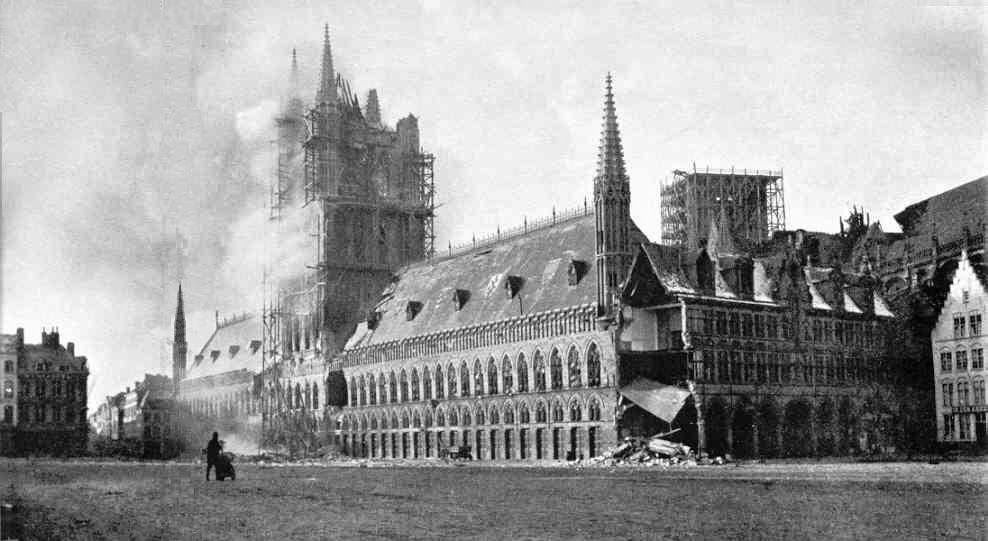In their first combat assignment on a European battlefield, it was up to the Canadians to defend the gaping left flank of the Ypres Salient after the gas attack on April 22nd. Through the valiant efforts of the 13th Battalion, the Canadian Black Watch, they managed to hold their ground until a counter attack was launched on Kitchener’s Wood late on the 22nd. Led by the uninitiated but determined 10th and 16th Battalions, the Canadians made substantial gains in spite of heavy casualties. Positions were consolidated on the 23rd but at dawn on the 24th another green cloud of poison gas seeped across the German lines. This time it was aimed directly at the Canadians.
The cotton-gauze masks issued to the soldiers were only moderately effective and did little to protect their eyes. They bravely fought through burning lungs, intense machine-gun fire and Ross Rifles that jammed continuously to hold off the intense attack until reinforcements arrived. Tragically, the 10th Battalion, perpetuated by the Calgary Highlanders, was all but wiped out.
Throughout the battle in the Canadian sector, Patricias prepared for an attack. With massive shelling and reports of breakthrough on both flanks it seemed a German charge was imminent. The Regiment, held down by continuous waves of artillery, cursed the poorly constructed trenches that had been such low priority for the French.
On the 24th, Lt. Col Buller informed the officers of the second gas attack on the Canadians. While the men could smell the chlorine they were fortunately not affected by it. As a precaution, however, they were told to use flannel strips or fill their socks with earth and hold them over their mouths. If it became necessary they were to soak them in baking soda or with their own urine - the latter remedy was not met with pleasant remarks.
 |
| Allied troops protect themselves during the 2nd battle of Ypres |
With every reserve battalion in the British 5th Corps engaged there was no possibility of relief for the Patricias for days. Their situation could have been much worse without the dedicated support of the transport units who never faltered in their commitment to deliver rations to the men under heavy fire and in spite of heavy casualties.
By April 27th, due mainly to the outstanding tenacity of the Canadians, the German attempt to capture Ypres from the north had failed.
The Canadian Division suffered 6035 casualties in just 48 hours, with more than 2000 killed. It was during 2nd Ypres that John McCrae was inspired to write the poem In Flanders Fields.
Poperinghe, Monday, April 26th, 1915
My dear Mabel,
After 4 nights in the trench, my Company came out at night and went into dugouts in the early morning, was shelled out, lost 9 men wounded. 1 killed in one hut. We went into rest works and were shelled out again. We now sleep out and live out in the woods scattered in little parties. The Germans have advanced on our right and left, in one place 3 miles. We have orders to make a bolt if cut off. Only a Regiment and a half here where we had a Brigade. So far our killed are small but our wounded list large.
The Canadian Division, who behaved very well, is wiped out and gone to Boulogne to await reinforcement. In one day 7000 passed through the distributing station wounded. We have lost most of our transport. Food is very shy. Ogilvie and Bainsmith hit. The latter is sticking it out. Ypres is destroyed and burned. The Germans came in thousands, using burning oil and gases. The French Turco Division broke up and the Canadians counter-attacked trying to hold the ground of 2 Divisions. The 10th Battn. lost all but 3 officers and 160 men. Two British Regiments are quite wiped out. The German Artillery is smashing ours at every point. I believe we are surrounded by spies.
I will try and get this out tonight with wounded men. The Ambulance arrangements have broken down. We are rushing in thousands of untried troops which in mean numbers may save the game but a big retirement seems certain. Ever your loving boy,
Agar
PPCLI casualites during the month of April were 15 killed, 78 wounded and 1 missing.


-1%2BPPCLI%2BWounded%2Bat%2BBase_all%2BOriginals%3B%2Bsgts%2Bwith%2Bdrill%2Bcanes%2Bc%2B1915.jpg)


